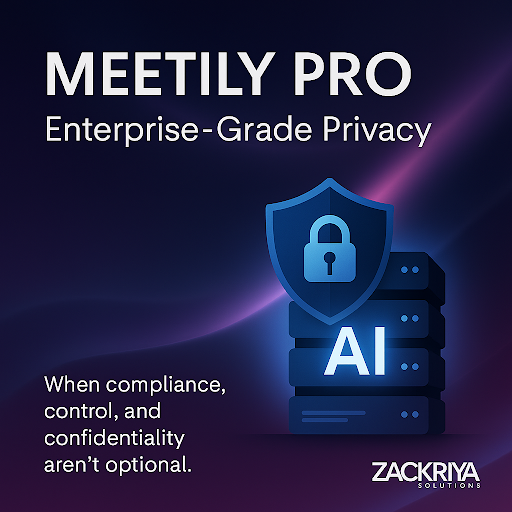Global enterprises face a critical challenge: harnessing AI’s transformative power while safeguarding sensitive data. As regulations tighten and cyber threats evolve, Privacy-First AI Infrastructure has become non-negotiable. Organizations that prioritize secure AI deployment from the ground up gain competitive advantages—enhanced trust, regulatory compliance, and resilient operations. This blog explores how enterprises can build scalable, privacy-centric AI systems that protect data without compromising innovation.
Key Takeaways
- Privacy-First AI Infrastructure protects sensitive data while enabling AI innovation through security-by-design principles
- Secure AI deployment requires encryption, access controls, and regulatory compliance frameworks like GDPR and CCPA
- Scalable AI infrastructure for enterprises balances performance with privacy through federated learning and edge computing
- Organizations that invest in privacy-first systems build customer trust and achieve long-term competitive advantages
Why Privacy-First AI Infrastructure Matters for Enterprises
Privacy-First AI Infrastructure protects sensitive information throughout the AI lifecycle—from data collection to model deployment. Traditional AI systems often centralize data in cloud environments, creating vulnerabilities and compliance risks. Privacy-first approaches embed security at every layer, ensuring data remains protected even during processing and analysis.
Global enterprises handle massive volumes of customer data, financial records, and proprietary information. A single breach can cost millions in fines, damage brand reputation, and erode customer trust. Privacy-first infrastructure mitigates these risks by implementing zero-trust architectures, end-to-end encryption, and data minimization principles. Organizations adopting these frameworks demonstrate accountability and gain stakeholder confidence. Moreover, custom AI solutions designed with privacy at their core enable businesses to innovate responsibly while meeting stringent regulatory requirements.
Core Components of Secure AI Deployment
Building secure AI deployment systems requires three foundational elements: data encryption, access management, and compliance monitoring. Data encryption protects information both at rest and in transit, ensuring unauthorized parties cannot access sensitive datasets. Advanced encryption standards (AES-256) and transport layer security (TLS) protocols form the baseline for secure AI systems.
Access management implements role-based controls that limit who can view, modify, or deploy AI models. Multi-factor authentication, privileged access management, and continuous monitoring prevent insider threats and unauthorized access. Compliance monitoring tracks data flows, model decisions, and system activities to ensure adherence to regulations like GDPR, CCPA, and HIPAA. These components work together to create defense-in-depth strategies that protect AI infrastructure from multiple threat vectors. Enterprises should also consider bringing AI to their data rather than data to AI, minimizing data exposure during processing.
Implementing Scalable AI Infrastructure for Enterprises
Scalable AI Infrastructure for Enterprises must handle growing data volumes, user demands, and computational requirements without sacrificing security. Cloud-native architectures with containerization (Docker, Kubernetes) enable flexible resource allocation and rapid scaling. However, scalability shouldn’t compromise privacy—enterprises should implement privacy-enhancing technologies like federated learning, which trains models on decentralized data.
Edge computing represents another critical strategy, processing data closer to its source rather than transmitting it to central servers. This approach reduces latency, minimizes data transfer risks, and ensures compliance with data residency requirements. Organizations can deploy AI models at edge locations while maintaining centralized governance and monitoring. Hybrid architectures combining edge and cloud resources offer the best of both worlds—local processing for sensitive operations and cloud scalability for non-sensitive workloads. Investing in AI automation solutions that support these architectures helps enterprises scale efficiently while maintaining privacy standards.
Privacy-Enhancing Technologies for AI Systems
Privacy-enhancing technologies (PETs) enable enterprises to extract insights from data without exposing sensitive information. Differential privacy adds mathematical noise to datasets, protecting individual records while preserving statistical accuracy. This technique allows organizations to share aggregated insights without compromising privacy. Homomorphic encryption takes this further, enabling computations on encrypted data without decryption—models can analyze sensitive information while it remains protected.
Secure multi-party computation (SMPC) allows multiple organizations to collaboratively train AI models without sharing raw data. Each party processes its data locally, sharing only encrypted results. These technologies are particularly valuable for industries like healthcare and finance, where data sharing traditionally faces regulatory and competitive barriers. Synthetic data generation creates artificial datasets that mimic real-world patterns without containing actual personal information, useful for testing and development. Enterprises must evaluate which PETs align with their use cases, balancing privacy protection with model performance and computational costs.
Building a Privacy-First Culture and Governance
Technical infrastructure alone doesn’t guarantee privacy—organizations need comprehensive governance frameworks and cultural commitment. Privacy-first culture starts with leadership prioritizing data protection and allocating resources to security initiatives. Regular training ensures employees understand privacy risks, regulatory requirements, and best practices for handling sensitive data.
Governance frameworks establish clear policies for data collection, storage, processing, and deletion. Data Protection Impact Assessments (DPIAs) evaluate privacy risks before deploying new AI systems, identifying potential issues early. Privacy by design principles should guide every development stage, embedding security controls from initial architecture to final deployment. Transparency mechanisms, including explainable AI and audit trails, enable organizations to demonstrate compliance and build stakeholder trust. Regular security audits, penetration testing, and vulnerability assessments identify weaknesses before attackers exploit them. Organizations that balance productivity with privacy create sustainable AI systems that respect user rights while driving business value.
Navigating Global Regulatory Requirements
Global enterprises must navigate complex regulatory landscapes spanning multiple jurisdictions. GDPR in Europe mandates strict consent requirements, data minimization, and the right to erasure. CCPA in California grants consumers control over personal information, including opt-out rights and disclosure requirements. Other regions have their own frameworks—China’s PIPL, Brazil’s LGPD, and India’s Digital Personal Data Protection Act.
AI-specific regulations are emerging, adding another compliance layer. The EU AI Act classifies AI systems by risk level, imposing strict requirements on high-risk applications like healthcare diagnostics and credit scoring. Organizations deploying AI globally must implement flexible compliance frameworks that adapt to regional requirements. This includes maintaining detailed documentation of data flows, model training processes, and decision-making logic. Appointing Data Protection Officers (DPOs) and establishing cross-functional compliance teams ensures ongoing adherence. Automated compliance monitoring tools track regulatory changes and assess system alignment, reducing manual overhead. Proactive compliance not only avoids penalties but also positions enterprises as responsible AI leaders.
Real-World Implementation Strategies and Best Practices
Successful privacy-first AI implementation follows a phased approach. Start with comprehensive data audits identifying what information is collected, where it’s stored, and how it’s processed. This visibility enables risk assessments and prioritization of security investments. Next, implement baseline security controls—encryption, access management, and network segmentation—establishing the foundation for secure AI deployment.
Pilot projects test privacy-enhancing technologies in controlled environments before enterprise-wide rollout. Choose use cases with clear business value and manageable complexity, such as customer service chatbots or predictive maintenance systems. Gather feedback from users, security teams, and compliance officers to refine approaches. Gradually expand to more complex applications, continuously monitoring performance and privacy metrics. Establish incident response plans addressing potential breaches or privacy violations, including communication protocols, remediation steps, and regulatory reporting. Partner with experienced technology providers who understand both AI innovation and privacy requirements, accelerating implementation while avoiding common pitfalls. Regular reviews and updates ensure infrastructure evolves with emerging threats and regulatory changes.
Conclusion
Building Privacy-First AI Infrastructure for global enterprises isn’t optional—it’s essential for sustainable growth, regulatory compliance, and customer trust. Organizations that embed security into every layer of their AI systems gain competitive advantages while mitigating risks. Secure AI deployment, scalable infrastructure, and privacy-enhancing technologies work together to protect sensitive data without hindering innovation. By fostering privacy-first cultures, implementing robust governance, and staying ahead of regulatory requirements, enterprises can confidently harness AI’s transformative potential. Start your privacy-first AI journey today—assess your current infrastructure, identify gaps, and take concrete steps toward building systems that protect data, empower users, and drive business success.
Frequently Asked Questions
Privacy-First AI Infrastructure embeds data protection at every layer of AI systems, from design to deployment. It uses encryption, access controls, and privacy-enhancing technologies to safeguard sensitive information while enabling AI innovation, ensuring compliance with regulations like GDPR and CCPA throughout the entire lifecycle.
Global enterprises handle massive volumes of sensitive data across multiple jurisdictions with varying regulations. Privacy-First AI Infrastructure protects against breaches, ensures regulatory compliance, builds customer trust, and mitigates financial and reputational risks while enabling responsible AI innovation and maintaining competitive advantages in privacy-conscious markets.
Secure AI Deployment implements end-to-end encryption, role-based access controls, and zero-trust architectures to protect data during collection, processing, and model training. It includes multi-factor authentication, continuous monitoring, and compliance tracking to prevent unauthorized access and ensure data remains protected throughout AI operations.
The core components include data encryption (at rest and in transit), access management systems, privacy-enhancing technologies like differential privacy and federated learning, compliance monitoring frameworks, audit trails, and governance policies that ensure accountability and transparency throughout the AI lifecycle.
Enterprises can leverage cloud-native architectures with containerization, implement edge computing for local data processing, and use federated learning to train models without centralizing data. Meetily’s approach demonstrates how hybrid architectures balance scalability with privacy by processing sensitive information locally while maintaining centralized governance.
Key technologies include differential privacy (adds noise to protect individual records), homomorphic encryption (enables computation on encrypted data), secure multi-party computation (collaborative learning without data sharing), and synthetic data generation. Each technology addresses specific privacy challenges while maintaining model accuracy and performance.
Major challenges include balancing performance with privacy requirements, integrating privacy-enhancing technologies without disrupting operations, managing complex compliance across jurisdictions, securing organizational buy-in, and addressing technical complexity. Resource constraints and rapidly evolving threat landscapes also complicate implementation efforts.




